Introduction: In this article – inspired by washing up all the dishes after Thanksgiving – Gena Philibert-Ortega makes the connection between dish washing and genealogy. Gena is a genealogist and author of the book “From the Family Kitchen.”
When did you first start washing dishes in your family? I was allowed to wash the dinner dishes when I was six years old. I begged for that job. For some reason that escapes me today, I thought it was a sure sign of importance to be allowed to wash the dirty dishes (by hand – we didn’t have a dishwasher until I was older). I had to use a step stool to reach the sink and my mom watched me with a clenched jaw, convinced I would break a glass. That’s how I began my dish washing career, that continues to this day.
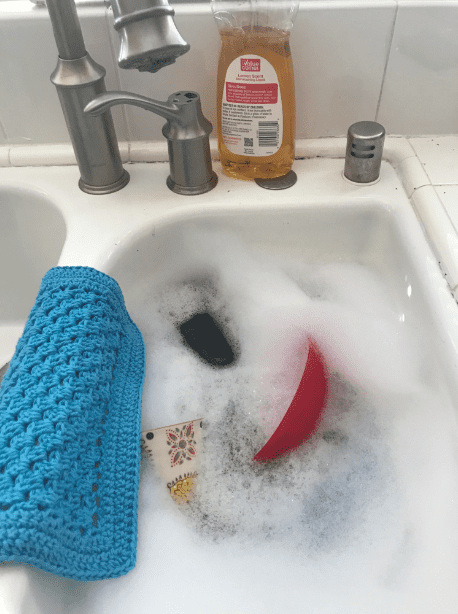
We all learn how to wash dishes a certain way. It’s a skill passed down from generation to generation and it’s influenced by beliefs about the “correct” way to wash dishes. Dish washing may seem like a trivial topic today, but historically it has been a serious one because of concerns over cleanliness and health.
While most of us learn from someone else how to do dishes, generations past read about the topic in home economic manuals and newspapers. Articles on the topic weighed in on everything, from the proper way to wash dishes and how to wash specific types of dishes, to what type of dish towel to use.
I bet you didn’t know that dish washing was such a complex topic?
Dish Washing 101
Dish washing is a skill that seems like it would be fairly easy to explain, but in reality, it’s those tasks that we see as intuitive that can be difficult to break down into simplistic steps. In my mind, there’s not much to explain: you fill the sink with hot water, squeeze some dish washing liquid in, and pile in the dishes. Once you scrub them with the dishcloth you rinse them in hot water and either dry them with a clean dish towel or let them air dry on the counter top.
But there are more in-depth directions for dish washing, including this one sent in to the Plain Dealer newspaper’s “Woman’s Exchange” column in 1915. Mrs. George W. Tullis of Knoxville, Tennessee, spells out exactly how she washes her dishes, a method that she says “saves time, energy, and many steps.” One way she saves her energy is by sitting on a kitchen stool while she dries her dishes.
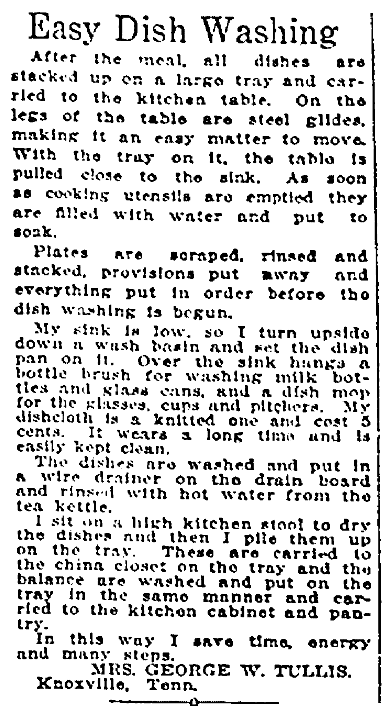
The basics of dish washing instructions are the same throughout time. Hot soapy water is one of the consistent requirements, but some of the other tasks associated with dish washing change. Take for example this 1922 article from the Montgomery Advertiser that starts with a discussion of the proper height of the sink or the table you are using:
“… [it] should be just the height that will enable you to stand straight at your task – and be sure you stand straight for it is the bending of the backbone which tires it and you – the correct height being when your hands just will touch, palm down, on the sink or table without your having to bend to do so.”
The article goes on to discuss how to clean the plates of any food prior to adding them to the dish water: “Before stacking them, take either a bread crust or half biscuit and wipe each dish off…”
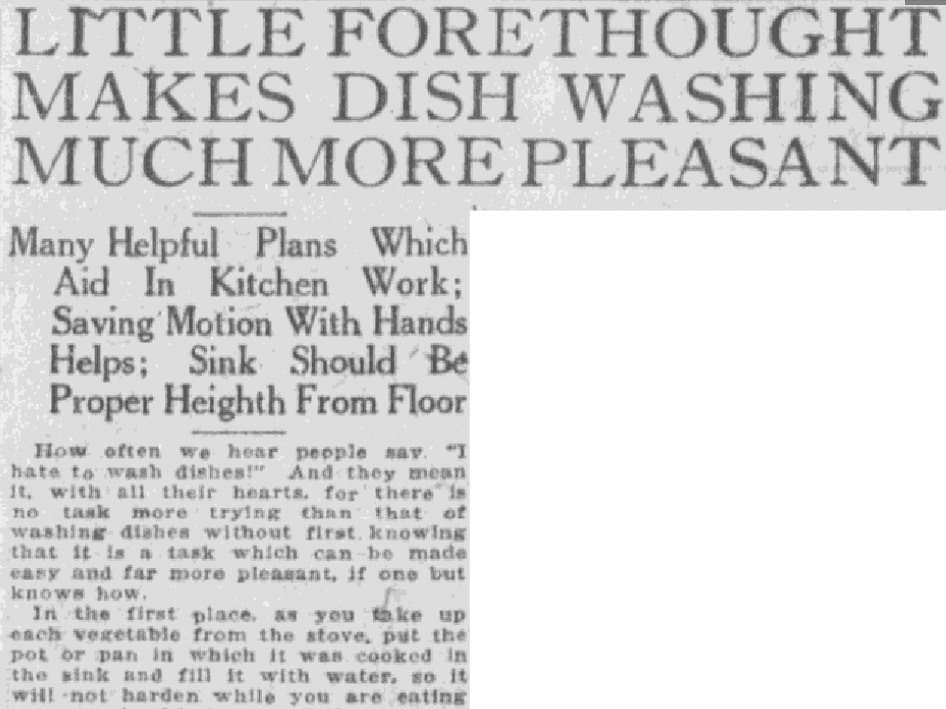
Dish washing instructions can also be found in other places, including cooking and home economic texts. The 1917 book Elements of the Theory and Practice of Cookery by Mary E. Williams and Katharine Bolston Fisher includes three pages on the “care of dishes.”

One of the ways she suggests to save time is to carry dishes from the table to the sink via a butler’s tray.
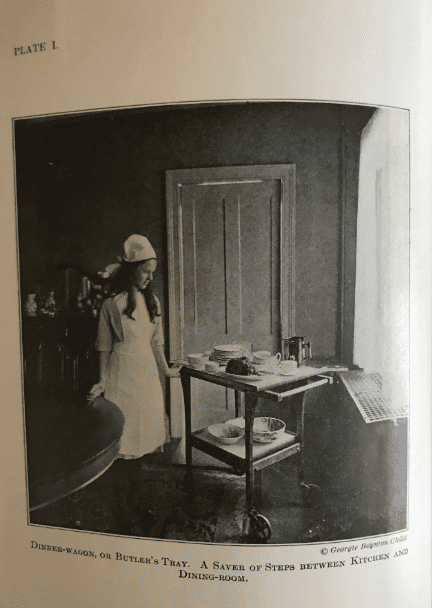
She also instructs that when you scrape the leftover food from the dishes, place the scraps in an “earthenware or enameled dish; wipe frying-pans and other greasy dishes with pieces of soft paper. This paper may be used for kindling.”
The Importance of Good Dish Washing
One reason these early 20th century texts taught the proper washing of dishes is because of their concern for germs and diseases that could be spread due to improperly washed dishes or the repeated use of dirty dish towels. This 1919 article from the Trenton Evening Times blames improper dish washing for the spread of influenza – an important warning during the deadly Spanish Flu pandemic.
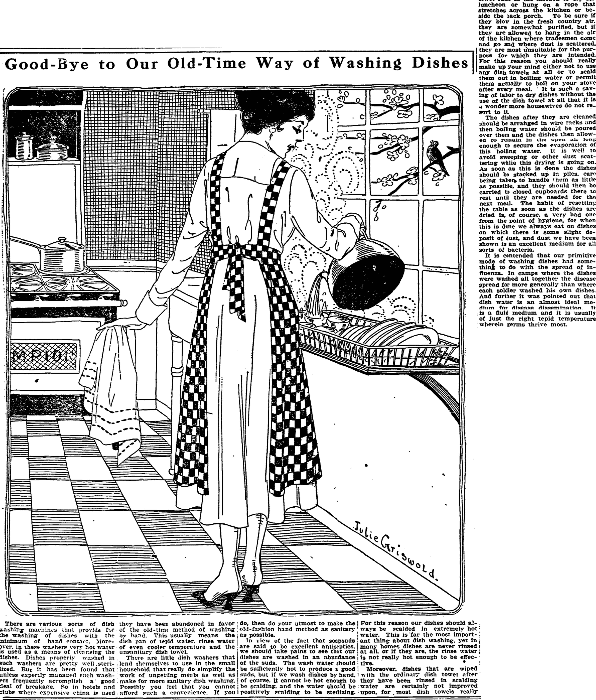
It is contended that our primitive mode of washing dishes had something to do with the spread of influenza. In camps where the dishes were washed all together the disease spread far more generally than where each soldier washed his own dishes. And further, it was pointed out that dish water is an almost ideal medium for disease dissemination. It is a fluid medium and it is usually of just the right tepid temperature wherein germs thrive most.
This newspaper article suggests that the proper method of dishwashing is to scald the dishes with hot water and use towels that have been scalded with hot water, hung in the outdoors where the air can purify them, or not to use dish towels at all.
In this rather patronizing 1911 article from the Plain Dealer about “rural sanitation,” the author proclaims that “country people are the hardest to convince of the value and importance of sanitary precautions.” It goes on to say that:
“…thousands of cases of tuberculosis are contracted through careless dishwashing. No dish is thoroughly cleansed and rendered sterile until it has been treated with an antiseptic solution like washing soda and thereafter immersed in boiling water. The old-fashioned dish cloth is a veritable paradise for germs, and the sanitarian declares that until the housewife uses better dishwashing methods germ diseases will certainly continue to be communicated to other members of the household.”
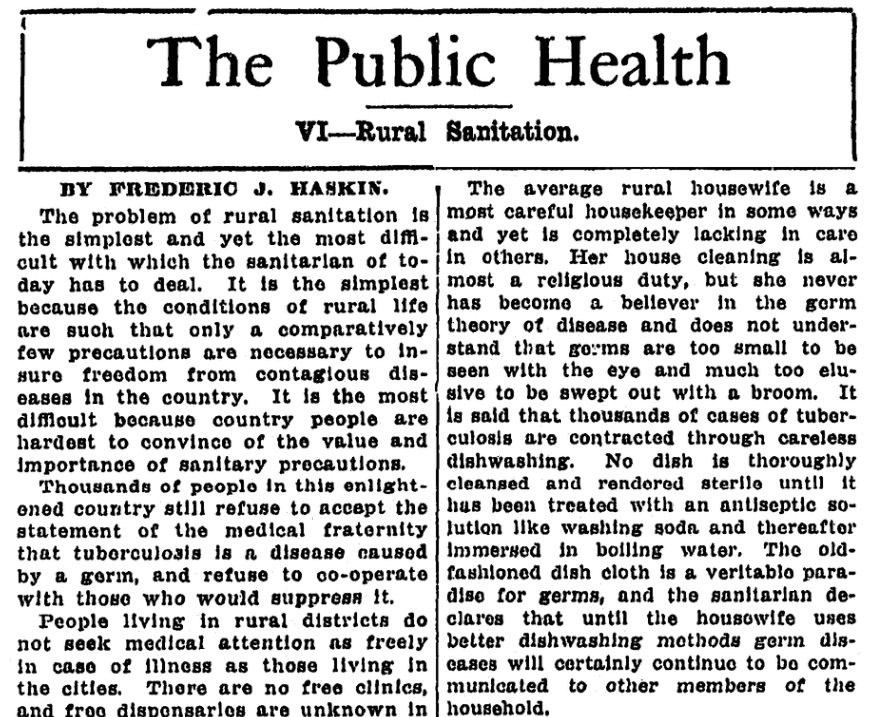
Thank Goodness for the Dishwasher
When I moved into my first house as an adult, it was an older home where I once again was the dishwasher. After growing tired of that task, I bought an old second-hand portable dishwasher. This dishwasher rolled to the kitchen sink and its hose attached to the kitchen faucet for its water supply.

When do you think the dishwasher was invented? Because your family may not have had one until the last 40 or so years like my family, it’s easy to assume that this labor-saving device is a rather new invention. You might be surprised to learn that the first dishwasher, although not successful, was invented in 1850! In 1887 Josephine Cochrane invented a dishwasher that would later be shown at the 1893 Chicago World’s Fair.*
In the early 20th century newspaper articles focused on how much better it was to use a dishwasher rather than washing dishes by hand because of the increased heat of the water. It was claimed that the end result of using this technology was a healthier family.
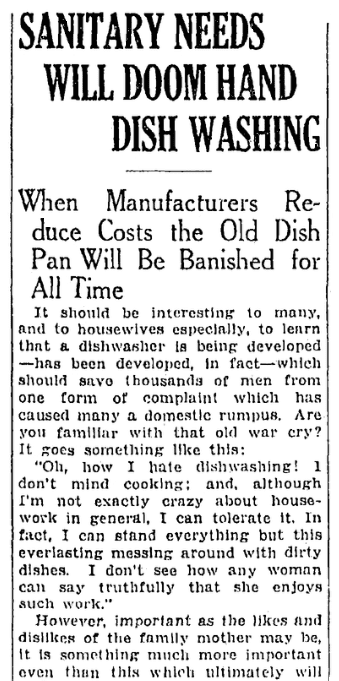
Dishwashing Is Family History
Ok, hear me out. You may not see the connection between washing the dishes and family history, but I guarantee there is one. Most likely the way you learned to wash dishes had something to do with the beliefs of previous generations. And how they were taught might have been influenced by things like concerns about germs, diseases, or washing different types of dishes and pots. Most likely dish washing was a family affair, especially at the end of a large family dinner like Thanksgiving. Maybe that’s when you saw the family china, or in the case of my maternal grandmother’s house, the grandkids did the dishes because her sink was low to the ground and not a comfortable “fit” for a woman who was about 5’8”.
Take some time to record your dish washing memories. Share them with the younger generations in your family and start a conversation about the memories you have that go with family meals and dish washing.
_____________
* “Dishwasher,” Wikipedia (https://en.wikipedia.org/wiki/Dishwasher: accessed 19 May 2019).

My mother stressed the importance of washing dishes in the correct order — glasses, plates, utensils, then pots and pans. We had a large double sink. The dishes were washed in one and dipped into the hot clear water in the second, and then put in the drainer to air dry. When there was illness in the home, she poured boiling water from the tea kettle over the dishes in their stand as shown in the newspaper image above. The ranch and farm houses of my youth were much cleaner than those of my town friends. I think it’s because we had to clean daily to stay ahead of the dirt that inevitably found its way in.
Kate,
Thanks so much for sharing that experience. It’s interesting how such a simple thing like dish washing has changed over time.
Thank you for reading and commenting on my article.–Gena